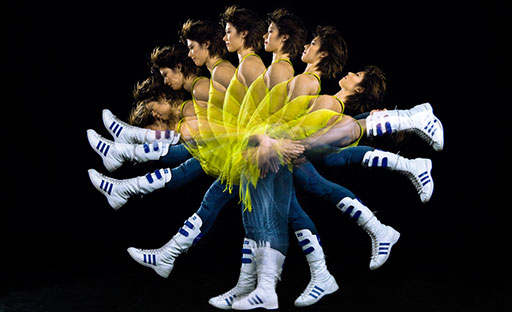Our Australian dance companies have been working on some brave and surprising collaborations that foster health, wellbeing and social change.
KAGE's Team of Life
Team of Life is a collaboration with a talented cast of young Indigenous Australians and teenage refugees living in Australia and tells a story that spans several generations, languages and codes.
This new work from Australian dance theatre company KAGE was developed using The Team of Life approach—a form of collective narrative therapy that uses sporting metaphors to enable young people to deal with traumatic experiences without having to speak directly about them. This methodology lets young people and older people who may not be used to speaking about aspects of their lives to engage in rich and meaningful conversations through sporting metaphors.
The ‘Team of Life’ approach was developed by David Denborough of Dulwich Centre Foundation initially in response to the experiences of former child soldiers from Uganda.
TEAM OF LIFE will have its world premiere at the Melbourne Festival from 16–20 October 2014.
Find out more about the show's development
There is a Post show Q&A on 20 October after the 1.00 pm show at The Coopers Malthouse Theatre. The creative team behind TEAM OF LIFE will talk about the process of developing the show and about the groundbreaking methodology behind it. There's also an Artist in conversation on Saturday 18 October at 1.00 pm at the Foxtel Festival Hub. Kate Denborough, director of KAGE, and performer David Nyuol Vincent will speak about art and trauma, and the places where the two converge.
Bangarra's Rekindling program Stories for Keeping Strong
Australian Dance Theatre's 'Proximity Clinical'
Technology used in the Australian Dance Theatre's show Proximity has inspired a new tool for stroke rehabilitation.
 Australian Dance Theatre's Proximity. Photo: Chris Herzfeld
Australian Dance Theatre's Proximity. Photo: Chris HerzfeldBut it all began with artistic exploration. A dance artist's exploration of the invisible connections between ourselves and the environment around us produced the dance work Proximity, which captured profound and beautiful ideas and made them visible through dance and video technology.
Proximity is Garry Stewart's work created with Australian Dance Theatre. Proximity led to Proximity Interactive, Garry's interactive video installation using Proximity's video effects (designed by French video engineer Thomas Pachoud), which led to Proximity Clinical.
Garry describes Proximity Clinical as 'a clinical application of Proximity Interactive to help with the rehabilitation of people with neurological damage, developed with Susan Hillier a neuroscience and rehabilitation researcher from University of South Australia'.
The Proximity Interactive installation was designed to invite users into choreographic play that explores the creative possibilities of their bodies. The video technology tracks and captures the user's movement in successive frames that provide real-time visual feedback about where each body part is in space. This same use was applied during the clinical trial to help stroke victims visually track and physically correct their unbalanced movement.
In July this year the ABC's '7.30 program' visited the clinical trial at Hampstead Rehabilitation Centre and their broadcast, Contemporary dance helps stroke victims in world-first, shows the rapid progress made by a young stroke victim taking part in the trial.
In the program, Associate Professor Susan Hillier explains how this new approach is opposite to her previous research that focused patients on the use of their body sense (feeling the movement) without the use of vision.
Thanks to art, creative exploration and Garry's vision, important and perhaps life-changing advances have been made in the research of effective rehabilitation approaches after stroke.
Shaun Parker's The Yard
An Australian choreographer’s collaboration with multicultural urban youth breeds confidence and respect for diversity.
both a high-octane piece of theatre and voice against bullying
‘The Yard’, which tackles loneliness, competition, survival and bullying, is the culmination of four years of collaboration between Shaun Parker and teenage performers from Captivate in Western Sydney.
Shaun manages to channel the fast-paced internet-fuelled dance forms and ideas that the young performers are adept in (look up jerking, dougie, krumping, hip hop and tutting) into a professional dance theatre work.
In 2014, The Yard opened 13 August and toured to Melbourne, Wagga Wagga and Griffith. Following The Yard's performance on the 14 August 2014, an 'Art for Social Change panel discussion' was hosted by Arts Centre Melbourne, Human Rights Arts and Film Festival, and Multicultural Arts Victoria.
BalletLab's LIVE WITH IT we all have HIV
BalletLab’s recent work LIVE WITH IT was created in partnership with the Victorian AIDS Council and was presented as part of The 20th International AIDS Conference.
 'Negative' from BalletLab's performance LIVE WITH IT we all have HIV. Photo: Jeff Busby
'Negative' from BalletLab's performance LIVE WITH IT we all have HIV. Photo: Jeff BusbyBalletLab’s artistic director Phillip Adams and visual artist Andrew Hazewinkel developed the work through a series of community workshops held across Victoria. It was performed by people who shared their different perspectives and personal stories about how the virus affects both those who live with HIV/AIDS and those who experience its effects in other ways.
In an interview with Stephen Russell on Gay News Network, Phillip describes the importance of tackling
‘the stigma surrounding HIV/AIDS head on, and that the spotlight provided by the International AIDS Conference in Melbourne is ideal. “These stories need to be archived in a cultural context, otherwise they will be lost. Many of the participants have never had this opportunity before, to have their stories presented.”’
Check out the LIVE WITH IT we all have HIV performance images on Facebook.

